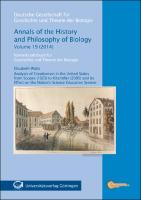Analysis of Creationism in the United States from Scopes (1925) to Kitzmiller (2005) and its Effect on the Nation´s Science Education System
Author(s)
Watts, Elizabeth
Collection
AG UniversitätsverlageLanguage
EnglishAbstract
Creationism is based on a fundamental belief in the inerrancy of the bible and negatively affects science education because creationist proponents insist on the inclusion of supernatural explanations for the appearance of species, in particular the origin of humans. This detrimental effect on education is particularly relevant in the United States, where almost 70% of the population rejects the idea of naturalistic evolution and the majority of American students struggle to meet the college-readiness benchmarks in science and math. This dissertation provides a comprehensive look at the issue from historical, judicial and educational perspectives. Twenty-four legal cases in the United States regarding anti-evolutionary strategies were analyzed in detail. Strategic trends were identified ranging from the statewide banning of evolution in public schools to the required teaching of Creation Science. The exact effect of creationist political activity was discerned through the analysis of state science standards and textbook adoption processes, which illustrated the creationists’ ability to lobby for a diminished coverage of evolution in science standards and textbooks. It was found that despite attempts made by scientific and educational agencies to provide guidelines such as the Next Generation Science Standards, the majority of American state science standards continue to be sub-par and one of the major flaws of these standards is the overall attempt to weaken the coverage of evolution throughout the standards. A similar loss of quality occurs in textbooks since publishers engage in self-censorship in order to avoid controversial topics such as evolution in order to prevent their books from being rejected. An examination of the free-choice learning materials revealed that creationist proponents are very active and successful in producing books, films and museums for the sole purpose of promoting creationism. Moreover, a brief look at the creationist movement in Germany provided a powerful comparison to the United States and elucidated the key components necessary for a creationist movement to exist and flourish, namely the presence of fundamentalist willing to fight to get anti-evolutionary materials introduced into science classrooms. This study provides new insights into the creationist phenomenon, present not only in the United States but also increasingly present in European countries such as Germany. Understanding the detrimental link between creationism and science education will help the science community realize that this topic needs to be continually readdressed and that it is imperative that these creationist trends are not dismissed as inconsequential. Der Kreationismus in all seinen Varianten geht weitgehend bis heute von der Annahme aus, dass die biologische Vielfalt nicht durch natürliche Ursachen, sondern durch Einwirkung übernatürlicher Kräfte entstanden ist (Einwirkung eines Schöpfer-Wesens). Nicht mehr hinterfragbare Begründungen sind dabei für kreationistisch geprägte Theorien charakteristisch, auch die ID-Bewegung setzt hier fort. In beiden Fällen (Kreationismus/ID) handelt es sich nicht um Theorien, da sie die Ansprüche, die man in der Wissenschaft an eine Theorie stellt, nicht erfüllen. Es sind vielmehr pseudowissenschaftliche, antidarwinistische Theoriengebäude die derzeit mit dazu beitragen, dass die „Religion“ generell in Misskredit gezogen wird. Diese Sichtweise kann sich auch negativ auf den naturwissenschaftlichen Unterricht auswirken, wenn Kreationisten bspw. versuchen, übernatürliche Erklärungen für das Auftreten von Arten im Biologieunterricht zu propagieren. Diese „weltanschauliche“ Interpretation ist besonders stark innerhalb des naturwissenschaftlichen Unterrichtes in den Vereinigten Staaten zu finden, wo fast 75% der Bevölkerung die naturalistische Evolutionstheorie ablehnt. Zudem sind die meisten amerikanischen Schüler unfähig, erfolgreich an naturwissenschaftlichen Universitätskursen teilzunehmen. Vorliegende Arbeit liefert eine erste umfassende Bestandsaufnahme des „Kreationismus-Phänomens“ aus historischer, rechtlicher und pädagogischer Perspektive. Es wurden hierfür 24 Rechtsfälle, die auf anti-evolutionärer Grundlage basierten, im Detail analysiert und die strategischen Tendenzen der Kreationismus-Bewegung identifiziert. Hierbei wird verdeutlicht, dass die kreationistischen Strategien Großteils als Reaktion auf die jeweiligen Gerichtsentscheidungen entstanden sind. Weiterhin wurde die direkte Einflussnahme des Kreationismus auf das Bildungssystem mittels staatlicher Einflussnahme auf Lehrbuchinhalte und Bildungsstandards im Fachbereich Biologie analysiert. Da die Inhalte von Lehrbüchern und Bildungsstandards vorwiegend durch politische Prozesse und Gremien in den USA festgelegt werden, gelang es so den Kreationisten, durch entsprechende politische Einflussnahme, die Wissenschaftlichkeit der Evolutionsbiologie innerhalb der Lehrbücher und Bildungsstandards herabzusetzen, mit der Konsequenz, dass das Thema „Evolution“ nur noch marginal unterrichtet werden kann. Zusätzlich ergab eine Analyse frei wählbarer amerikanischer Lehr- und Lernmaterialien, dass die Kreationisten auch sehr erfolgreich darin sind, ihre Ideen entsprechend zu vermarkten (Bücher, Filme, Errichtung von Museen), um so ihre Ziele auch außerhalb des Klassenraumes zu stärken. Ebenso wurde die Kreationismus-Bewegung in Deutschland dargestellt. Dieser Vergleich zwischen den beiden Ländern soll mit dazu beitragen, die generellen Schlüsselkomponenten kreationistischer Bewegungen aufzudecken. Die Studie liefert hier neue, detaillierte Einblicke in die Kreationismus-Bewegung und zeigt, dass diese Strömung derzeit weiter sehr aktiv und erfolgreich ist. Überdies wird gezeigt, dass der Kreationismus (ID-Bewegung) sich nicht nur in den Vereinigten Staaten ausgebreitet hat, sondern auch zunehmend in europäischen Ländern zu finden ist.
Keywords
Creationism; USA; TextbookDOI
10.17875/gup2018-1065ISBN
9783863953393OCN
1038399638Publisher
Universitätsverlag GöttingenPublication date and place
2018Classification
Biology, life sciences


 Download
Download